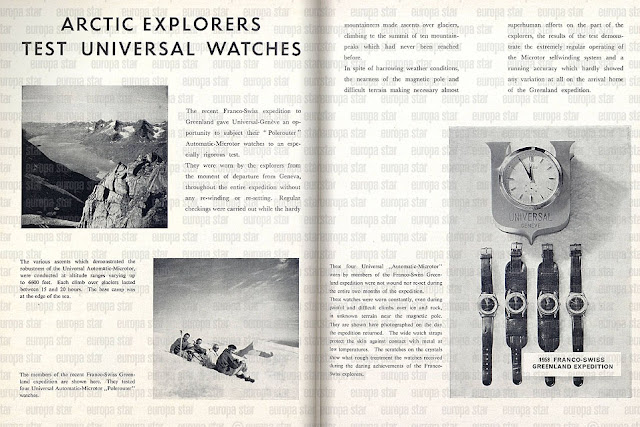By Bruce Shawkey
Universal Genève SA is a Swiss luxury watch company, founded in 1894 as Universal Watch. Since its beginnings, the company has produced complete watches with in-house movements. Along with neighboring Geneva companies Audemars Piguet, Girard-Perregaux, Patek Philippe and Rolex, Universal is internationally regarded for its style of craftsmanship as a manufacture d'horlogerie. Universal Genève is known for creating the first-ever chronograph in 1917.
Started and briefly based in Le Locle, co-founder Ulysse Perret would relocate Universal to Geneva in 1919, solidifying the company's status as a Genève brand. During the company's tenure in much smaller Le Locle (Neuchâtel region), Perret had conceptualized the company as Universal Watch in 1894 with classmate Numa-Emile Descombes, both of whom were horology students at the time. Although Universal began only as a manufacturer and retailer of cases, crowns, dials and movements, the company whilst under Perret and Descombes patented the brand's first 24-hour indication watch.
After Descombes' death in 1897 at the age of 34, Perret recruited Louis Edouard Berthoud as a co-manufacturer of complications,[2] and both briefly operated under the registered name Perret & Berthoud before switching to Universal Watch et Company (UWEC) Genève, Ltd. after relocating to Geneva. Under both trademarks, the horologists created various pocket and trench watches for both sides during World War I By 1925, the duo created the brand's first patented self-winding timepiece called the Auto Rem, an octagon-shaped men's wristwatch with lozenge-styled hands and a 15-jewel movement.
Following Perret's passing in 1933, his son would take over management, and Universal would remain a family-run business for 30 more years.
The Tri-Compax Chronograph
After the pocketwatch started to lose usefulness in favor of the more convenient wristwatch during the first world war, Universal seized the opportunity by creating the Compur in 1933 and the Aero Compax ("Aviator's Compact Chronograph") in 1936,[5] shortly before the start of World War II. In addition to its automatic "smooth sweep" timekeeping, the Compax was also equipped with a built-in stopwatch which made it a suitable device for soldiers during training exercises and full-fledged combat operations. The Compax was produced in many variations including the Moon Phase, Medico, Tri-, Uni-, and Master Vortex.
During the same period, Universal briefly collaborated with Parisian high fashion brand Hermès and designed the Pour Hermès ("For Hermès") chronographs, which featured square button registers, telemeters and tachometers, a movement containing a Breguet balance spring, and an Arabic-numeral dial. Hermès' Paris headquarters would in turn act as a major sales hub for all Universal brand watches in Europe until the 1950s, while the Henri Stern Watch Agency in Manhattan, the U.S. distributorship of Patek Philippe, would be an official Universal Genève dealer in North America.
Universal's popularity with the chronographs caught the attention of high-ranking government officials throughout Europe, including the Dutch Royal Family, who granted the Swiss brand a Royal Warrant in 1939 to issue a military watch for the nation's army, with then-Queen Wilhelmina's initials embossed on the dial.[8] The Dutch army utilized this watch up until Nazi Germany bombed Rotterdam in May of the same year and occupied the Netherlands until 1945.
Arguably the most well-known Universal watch of the post-war era was the Polerouter. Designed by Gérald Genta, it was originally produced as the Polarouter in 1954, appearing with a Cal 138SS Bumper movement. The following year it was replaced with the innovative Cal 215 microtor movement which, with minor changes and a name change (from Polarouter to Polerouter, in 1955), was produced until late 1969.[11] In its initial fifteen years of production, the watch was produced in many variations including the Polerouter de luxe, Polerouter Jet, Polerouter Super, Polerouter Genève, Polerouter Compact, Polerouter "NS", Polerouter III, and the Polerouter Sub diver's watch. The Polerouter's durability under extreme temperatures and fluctuating altitudes made it a preferred timepiece among Scandinavian Airlines' pilots who made flights over the arctic. The worldwide acclaim of the Polerouter Date was comparable to the reputation of similar Genève automatics like the Rolex Oyster Date and Omega Seamaster Date.
Here are some ads and pictures of Universal Geneve watches over the decades:
 |
| Polerouter electric circa 1965 |



























No comments:
Post a Comment